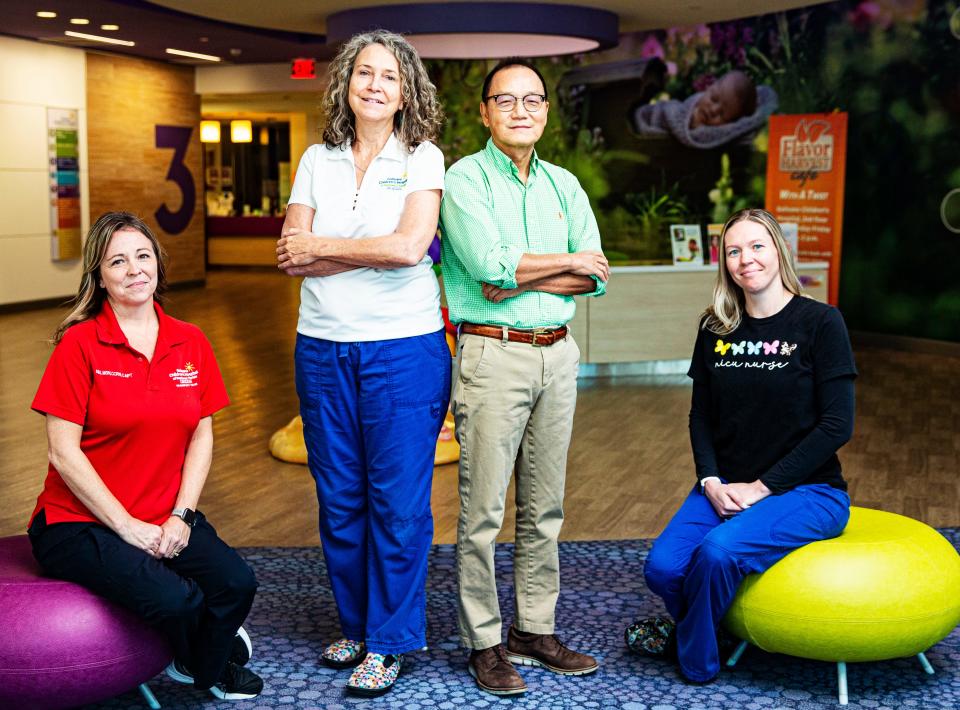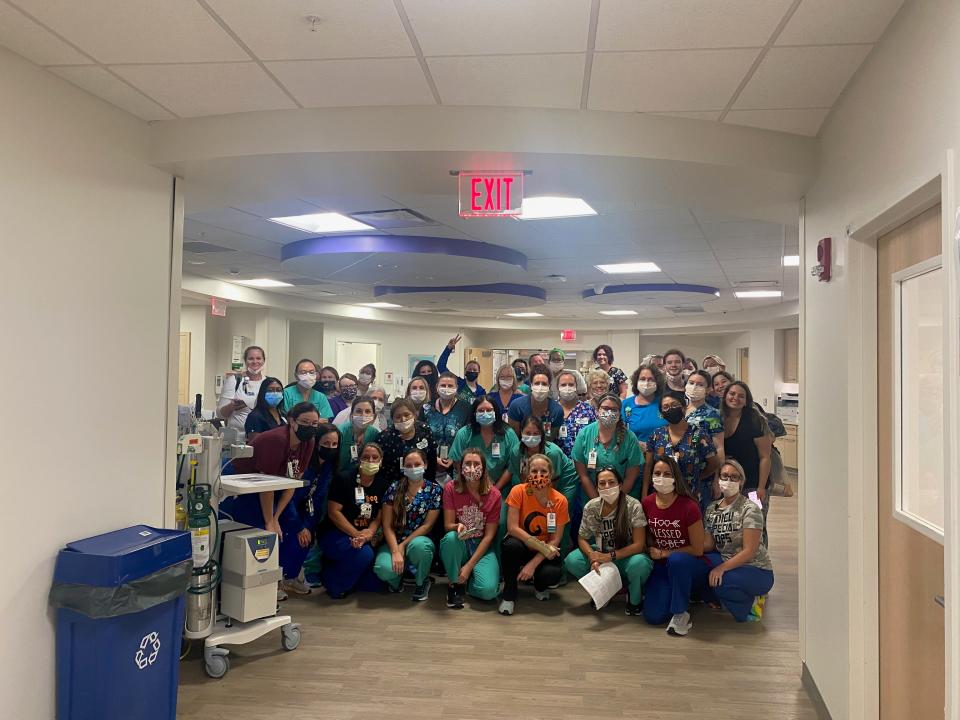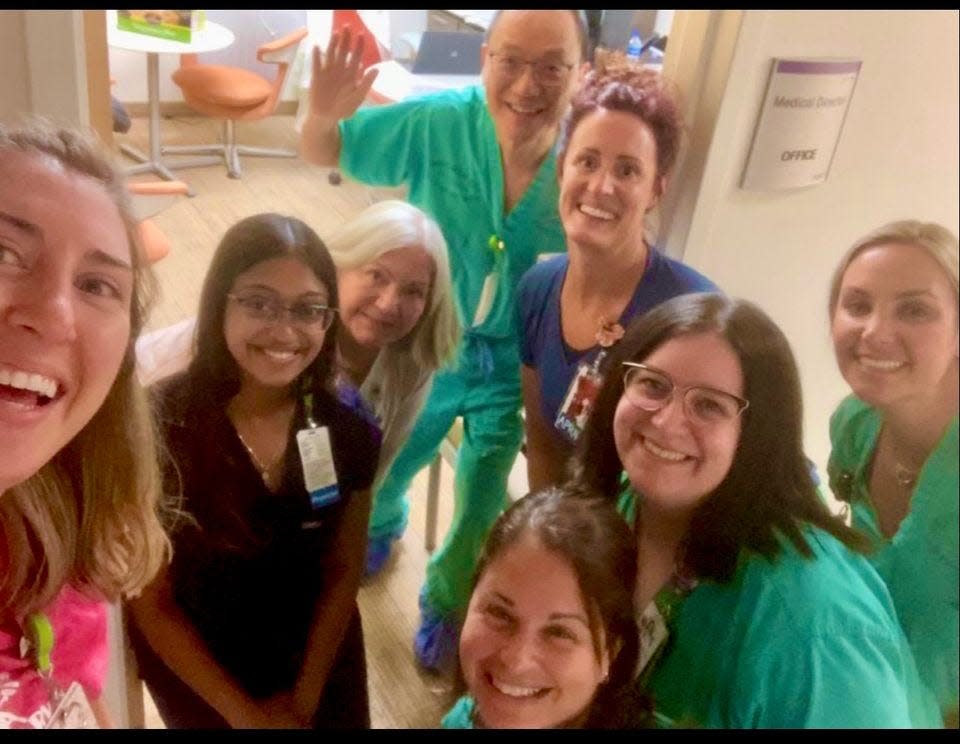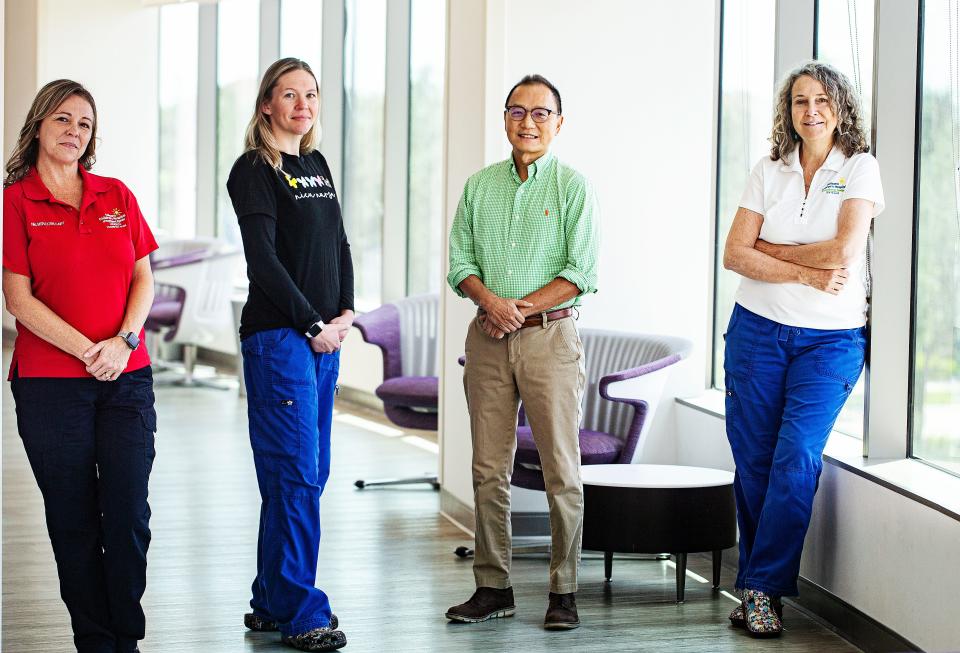29 Hours: How the Golisano Children's Hospital NICU team met the challenge of Hurricane Ian
On September 28, 2022, Fort Myers, Southwest Florida sustained a direct hit from Hurricane Ian, a Category 4 hurricane. Lee County suffered greatly, with extensive catastrophic damage, especially to all the waterfront communities, including Fort Myers Beach, Sanibel Island and Pine Island.

Due to loss of water pressure, government agencies mandated evacuation of Gulfcoast Medical Center, HealthPark Medical Center, and Golisano Children’s Hospital of Southwest Florida.
On Sept. 29-30, 2022, all in-patient units of Golisano Children’s Hospital, 80 patients were evacuated. The NICU census on Sept. 29 was 68, and in a 29-hour period, decreased to zero.
Seven babies were discharged to the parents and 61 babies were evacuated to 12 out-of-county healthcare facilities throughout the state.
Of the 61 evacuated babies, 20 were categorized as level 3/ critical care and the others were intensive care level 2 patients. There were no reported adverse events.
Here is the story
Residing in Florida means living with the risk of hurricanes. Here in Southwest Florida, we are respectful in our fear of what Mother Nature can dole out, and yet retain some sense of self-assurance, and maybe a bit of overconfidence, having prepared for so many hurricane seasons.
Then came Ian…
Friday, Sept. 23, 2022: It starts
The National Hurricane Center is tracking Tropical Storm Ian.
10:19 a.m. I send a GroupMe tickler to my group: “Starting the hurricane drill folks. Best to hit Costco before the rush. See ‘Hurricane Preparedness’ section of our manual.”
Monday, Sept. 26, 2022: Ian strengthens
Hurricane Ian has strengthened to a Category 2. The forecast path predicts landfall in the Tampa Bay, Pinellas County area.
4 p.m.: LeeHealth initiates partial activation of Code Brown: Team A are those designated to staff the hospital, and Team B are those who will replace them, when possible, post-storm. Our neonatal intensive care (NICU) medical Team A: four neonatologists and four neonatal nurse practitioners (NNP) will stay in house. Everyone else will be Team B.
9:22 p.m: An NNP sends us all a GroupMe photo, an evening sunset view from her backyard in Punta Gorda. A backyard canal, 15-foot bowrider fishing boat to the side, with silhouetted palm trees. The water is mirror-flat, reflecting the emerging night sky at sunset- a splash of yellow, orange, and red pastels. Beneath it, she types: “The calm before the storm.”
Tuesday, Sept. 27, 2022: Preparation
6 a.m.: Ian is a category 3, over Cuba. Projected landfall has shifted south, away from Tampa, to between Tampa and Naples.
11:41 a.m.: Code Brown! “Team A is activated.”
By early afternoon, most of us are completing rounds. There is a bit of a ‘Grand Central Station/mass sleep-over’ ambiance. For many, this is a first-time experience. The mood is a bit upbeat, with an undertone of fearful excitement. Many of the staff have been through Irma and recall the non-lethal, but significant damage we sustained. Some are reliving the anxiety that comes with uncertainty.
Staff must pass through a billeting process, and classrooms, staff lounges, offices, storage areas are all assigned for staging and sleeping areas. Unlike previous years, the hospital policy no longer allows family or pets to be billeted with the storm.
Thank goodness for cell phone service; our phones are even more omnipresent than usual. Although the individual patient rooms remain quiet and subdued, we are all engaged in a multi-tasking dance of work, and simultaneous texting pings, or phone or Facetime conversations with concerned friends and family, locally and nation-wide.
Our nursing director and managers are orchestrating the staff activity. LeeHealth administration email updates identify our priorities and preparation. “This is not our first rodeo, team. We got this!”
4 p.m.: Rounds are done. I am assigned to be on-call tonight and have received sign-out from my colleagues. It’s strange because the folks signing out are still here. The NICU Administrative suites are in the back of the neonatal unit, and the medical and nursing leadership office are adjacent. We all settle in, while small groups congregate. Weather updates play incessantly in the background.
5 p.m.: Personal update: I live close to the hospital and four miles from the beach. We are in an evacuation zone, but my wife will ride out the storm in our home. Many of my neighbors have also chosen to stay.
7:30 p.m.: The NICU physicians, nurse practitioners, nurses and respiratory therapists gather for a group photo. We are all smiling beneath our masks. No need for jerseys; we self-identify via text, “Team A!”
8 p.m.: I make evening rounds with the night team. We review several stable ELGAN babies on high frequency ventilatory support; a thanatophoric dysplasia with no acute change in status, and a ‘22 wk’er’ with focal perforation and a drain, as well as a severe chronic lung disease infant flirting with need for tracheostomy. There is an infant with a challenging combination of caudal regression and urogenital malformation and another infant with post-hemorrhagic hydrocephalus and a shunt. Then there are the usual blend of babies weaning off support or feeding and growing on little or no respiratory support. We focus on the clinical issues − there is some comfort to the familiar and routine, but inevitably, any of the usual banter gravitates to the latest news.
11 p.m.: Hurricane Ian has grown to a category 4 storm, with projected landfall somewhere between Sarasota and Fort Myers. The news stations are drumbeating a frantic warning of dire consequences for all in Ian’s path. Storm surge warnings are now up to 12 feet.
Night call is uneventful, but I sleep only sporadically.

Wednesday, Sept. 28, 2022: Hurricane Ian arrives
5 a.m.: Ian has undergone an eyewall replacement cycle. The weaker inner eyewall is spontaneously replaced by a stronger outer eye wall, and allows re-strengthening, with even higher wind energy. With hurricane force winds 80 miles across,
Ian has reached a strong Category 4 intensity; storm surge warnings are now 18-20 feet, and described as catastrophic, and the worst on record. The forecasted landfall is now a collision course with Fort Myers.
5:30 a.m.: I wake up to this latest update. Ian’s path is reminiscent of Hurricane Charley (2004) which also was heading towards Tampa and had suddenly veered toward Port Charlotte; but Hurricane Charley would fit in the eye of Ian, and worst yet, is moving much slower. I call my wife and unsuccessfully plead with her to come to the hospital. “I have room in my office.” She questions why she should be allowed to come when others in the hospital are not able to bring their spouses? A fair ethical question, but at that moment, I don’t care.
My wife and I will face this one apart, and I quietly fear for her safety.
Golisano Children’s Hospital was built as a state-of-the art facility in 2017. It shrugs off category-4 winds and
is wrapped in a sturdy wall of glass that provides us a panoramic view.
7:30 a.m.-11 a.m.: Rounds are a bit distracted. There is an angry howling of the wind, and trees bend ever more violently around us. The hospital goes to generator power by midmorning. The first floor is evacuated by early afternoon.
1 p.m: Outside, debris is flying everywhere. Below us, we watch as the bus stop canopy slowly rips from its pilings, and blows away, and trees shutter and crack before becoming uprooted. Through our window view, we are introduced to the storm surge. Bass Road, which is adjacent to our bus stop, is now a turbulently flowing river. Staff members watch the hospital parking lots, as row after row of parked cars, shrink away to the rising tide. An NICU nurse points at a floating vehicle and exclaims, “that’s my car!”
3 p.m.: I contact my wife by text. Our house is on generator power. The water level has risen above our neighbor’s white picket fence.
3:25 p.m.: Hurricane Ian makes landfall near Cayo Costa, with winds near 150 mph.
5-6 p.m.: Frightening videos of total inundation trickle out of Fort Myers Beach and Sanibel Island before total loss of contact.
5 p.m.: The administration has had regular interval assessments. I navigate the evacuated first floor corridors to attend one of these meetings and walk pass a back hallway loading dock. Workers are frantically unloading boxes. I pause, feeling the wetness and force of the wind, and squint to see beyond the shadowy figures. I can see a black ocean lapping up to the dock…with breaking waves and white crests! I peer into the abyss, and then hurry on my way.
6 p.m.: I receive a call from the System Incident Command lead. She asks about our census and patient acuity. We have already triaged the NICU patients, the number of ventilators, type, other modes of support as well as levels of care. We must decide who has the best chance of survival if we need to move everyone emergently. We also identify potential patients that might be discharged within the ensuing 24-hours. This is the first time I hear that we might need to evacuate the hospital.
6:30 p.m.: The Golisano chief medical officer (CMO) informs me that the hospital has lost water pressure and describes how the maintenance engineers are now pumping water from our adjacent lake to maintain pressure. However, we are no longer able to provide working toilets, nor maintain adequate water pressure to run the fire suppression sprinkler systems.
The faucets still work, but the community water supply has sustained fecal contamination. We must now use bottled water for patient care. Our nurses carefully ration a limited bottled water supply used for our babies. Buckets of water are used to flush the toilet − limited to micturition. We must defecate into a plastic bag and place them in the trash. We laugh as a NNP volunteers, “give me a bag, looks like I’ll be the first.”
I speak with one of our dedicated housekeepers who accepts her new duties without any sense of repulsion or hesitation.
6:45 p.m.: Cell phone coverage is becoming sporadic. Our home generator is now submerged- no power, and the water levelhas risen to the steps of our house. I ask my wife to don my wet suit; she jokes about getting my suit past her hips, and we both laugh nervously. The pantry closet is the safest location, with egress to our attic. She positions a ladder to allow easy access, and relocates essential survival supplies as well. Midsentence, she loses cell phone service, and I am unable to reach my wife for the next 23-hours.
7 p.m.: I text message with my son in Philadelphia. His concern is palpable, but he remains a calm and thoughtful presence, relaying information to and from me, and back to the rest of the family.
9 p.m.: The night team makes rounds. That evening, there is only one admission- a 31-week gestation infant with respiratory distress syndrome…no problem. And the parents are happy to stay in the hospital.
11 p.m.: Patient care conditions might deteriorate rapidly. We must not have a fire. How are the staff holding up? Has the storm surge extended into my home? I find some quietness from my mind…in sleep.
Thursday, Sept. 29, 2022: The aftermath

Gov. DeSantis calls Hurricane Ian a “500-year flood event.” Damage assessments will be catastrophic and historic.
5 a.m.: I attempt unsuccessfully to contact my wife.
7:06 a.m.: GroupMe post: “Is everyone ok?” “Exhausted after being here since Tuesday morning…but at least we are alive.”
7:30 a.m My car is not submerged! The water level is low enough to drive towards home. There are hanging powerlines and the signal lights are strewn along the side of the road; driving is treacherous. My neighborhood is an expanse of water, too deep for vehicular access. Back to the hospital.
8 a.m.-10 a.m.: Before rounds, I can see Chinooks and other military helicopters flying overhead. I hear reports of arriving armed National Guard troops. The water supply remains unsafe.
10 a.m: Our pediatric transport director is teleconferencing with the Florida Neonatal Transport Association, and the Florida Association of Critical Care Transport Specialists. I later learn that our hospital administration, guided by a coordinated array of local, regional, and national agencies − ESF8 (Emergency Support Function# 8), FEMA, Tallahassee emergency operations center, the Florida Hospital Association, the Agency for HealthCare Administration, and other agencies − have been working to identify available hospital beds throughout the state. They are implementing a cooperative multi-state plan to mobilize emergency medical services.
12 p.m.: Our CMO (Chief Medical Officer) speaks with my entire medical team. We are notified that the hospital system has already begun to evacuate adult patients, and we must plan to evacuate pediatric and neonatal patients as well. We currently have 68 babies in our NICU, many with long and complex hospital courses. We review the challenges to our normal patient transfer process. Parents, already stressed with their baby’s current condition, some who may now face homelessness or additional undefined burdens, must be compassionately informed. Our clerks, nurses and medical providers need time for appropriate discharge/ transfer documentation.
Recipient facilities and beds must be identified, and transport arrangements made. We must ensure a direct physician or nurse practitioner communication with the appropriate recipient medial team provider. This is our only formal discussion of plans for evacuation. At this moment the timeline is not clearly defined.
1 p.m.: Our Golisano hospital evacuation will now take priority. The NICU evacuation will take place now!
Our transport director and nursing leadership set up a ‘transport command central.’ Our government agencies have already mobilized available beds, and transport resources.
1:24 p.m.: Fort Myers Beach…completely washed away.
1 p.m. to 5:30 p.m.: Apparently driving since early morning, a phalanx of ambulances forms along the perimeter of the hospital. They are converging from many states. “Your transport is here, which baby will be going?” These are not normal times, and the cart is pushing the horse.
My phone is exploding. Medical directors throughout the state are reaching out. “Hi Bill…please call me to discuss the NICU babies you plan to transfer; Hi…I heard that 10 babies are on their way. I have no information about any of them; Hello, this is …please call me when you have a chance.”
The medical providers phones chime incessantly. “Is baby ‘X’ ready to go?” Where? Who has been told? I haven’t written my note yet! I still need to speak with the mother!
3 p.m.: I enter the room of a premature baby who is doing well, a “feeder and grower,” and inform his mother of our plans for evacuation. She has had little sleep and cannot contact her husband. She pleads in a subdued tone. “Why does my baby need to go now? Can I refuse? Where is Port St. Lucie? I have family in Miami.” She wrings her hands, and tears stream down her cheeks. My gut feels her loss of control. I had just previously returned from our command central to prevent an unnecessary transport of a baby placed on the transport list who was triaged for discharge to home. This is rectified quickly, and we discharge him to his mother, avoiding an EMS team poised to take him to Martin County. A good catch!
The transport coordinators work steadily and calmly under extreme pressure. We are all making many situation-specific adjustments to avoid mishaps. There is no blueprint for this. I make a quick return trip to my “feeder and grower’s” room. We have re-routed her baby to a facility in the Miami area. Mom smiles through her frown.
So many complex patients, so many risks inherent in hand-offs.
I am truly appreciative of the utility and facility of our neonatal electronic medical records, coupled with the diligence of the medical team.
5 p.m.: Team B is activated. Hospital-wide, our staff dutifully report in…many are silent, some seem stunned. I suspect their faces betray a shared tribulation.
Our medical team A will remain in-house. Two team B nurse practitioners come in this evening; the rest will arrive tomorrow.
5:37 p.m.: I solicit a ride in a pickup truck with a high cabin. My neighborhood remains a lake, but guided by the tops of mailboxes, we arrive at my home. My wife is fine, and I am internally buoyant! I take a selfie with her and return to the hospital; our parade of neonatal transports continues.
11:30 p.m.: Our team, exhausted both physically and emotionally, has been working non-stop. We send out our 50th baby close to 2 AM.
Friday, Sept. 30, 2022: NICU census: zero!
Ian weakens to a tropical storm and crosses to the Atlantic... re-strengthened to a category 1 hurricane, making landfall on the South Carolina coast near Georgetown, and subsequently dissipates.
8 a.m.: Team B members are welcome sights. I think of a scene from the movie Glory, where rolls of fresh troops, marching to the front line, pass by their war-weary, retreating colleagues. I greet my associate medical director who will smoothly oversee the following week of transition.
5 p.m.: Our last baby is evacuated from the NICU. We have discharged or transferred out 68 babies over a 29-hour period, and without a single adverse event! Like diamonds, our teamwork has been forged under extreme pressure. I have never been more proud and thankful to have the opportunity to work with all my dedicated colleagues- doctors, nurse practitioners, nurses, management, and administration.
That weekend, with water levels receding, my wife and I walk down our still-flooded street. Many neighbors also emerge and share their stories.
One family relates how, from their second story bedroom, they witnessed a surreal expanse of water roll towards them. The wife exhaled, “I think we are going to die!” Shortly after this, they describe how their two cars floated down the road. The storm surge was so unexpected, another family (husband, wife, and small dog) find themselves surrounded by rising waters, even as they attempted to walk to their next-door neighbor’s home on higher ground. Instead, they jump into their boat (on a trailer hitch) that is now floating, and throw out the anchor, hunkering down, while buffeted by hurricane force winds, rain, and waves. They stayed huddled in their boat for two hours before they struggle to their house attic.
A third family, with two children and both sets of grandparents scrambled to their attics, as their house filled with seawater, contaminated by sewage. Fumes from their generator gas tank began to accumulate in their attic, and the husband must descend from the attic, wading through feculent water, to their garage. A fourth neighbor with several children and dogs, found and donned life jackets, and scrambled to their attic.
Those who go to the attic should bring an axe to chop their way out if needed. Two weeks later, a nurse viscerally recalled how she, her husband and adult son survived. She described how they frantically piled their furniture against bowing doors; how they had to scramble to the interior closet, hearing cracking sounds as her house began to break away.
Her voice and face remained tense and strained as she relived her nightmare.
“I really lost it when I watched my husband and son holding each other and saying their good-byes.”
I hugged her, although I knew I could not hope to take away her pain.
“Why are you working?” “I don’t know…I just needed to be somewhere familiar and hold a baby.”
While we all sustained varying degrees of material damage and loss, so many of our experiences paint a similar picture of intense fear and realized or unrealized trauma.
10-15% of Golisano staff lost their homes. Of the neonatal medical team, one lost his home, three others sustainedsignificant roof damage. Of the 13 homes along my neighborhood street, seven were flooded. We all survived.
Epilogue

Hurricane Ian is the second costliest and deadliest storm in U.S. history.
Our hospital system bounced back quickly. For the Golisano Children’s Hospital NICU, full water pressure was restored within the week. About three-weeks post-Ian, the NICU was back to baseline, fully staffed, and with a census of 58.
All but one of our evacuated babies returned or were discharged.
My wife suggested that I write down my thoughts, in part, as therapy. I am still trying to fully reconcile the impact of Hurricane Ian to the community, to my colleagues, and to myself.
Are there any lessons to be learned…maybe.
“No man is an island?”
Indeed, the human condition is intertwined, on all levels. The community was well served by the proactive preparations of the state and national agencies, as well as so many independent services and individuals who had descended upon our beleaguered community and provided support.
One month following Ian, the signs of recovery were everywhere: FEMA, police cars, food and clothing stations, utility vehicles, many with out-of-state license plates. At a local Lowe’s, a BBQ stand was dispersing free meals. Our NICU classroom had doubled as a thrift shop, sharing clothes and essentials; everyone helped everyone.
It is now about almost one year post-Ian. The news cycle has long ago moved on, and ostensibly so have the rest of us. Almost defiantly, we seek the comfort of normalcy. My colleagues and I have quickly refocused on our workday routines. On one level we struggle with denial, on another, “survivor guilt’ may linger. On a third level, I wonder how many who continue to struggle now feel forgotten?
Indeed, some of us remain frayed and violated, and have found our human connections to be that much more vital and sustaining. Together and individually, through ingenuity, fortitude, compassion, and resilience, we are building ourselves back.
It is difficult to quantify the enduring emotional trauma.
Together, our community will recover, as will each of us…over time.
William Liu, M.D., is the Medical Director for the Neonatal Intensive Care Unit at Golisano Children’s Hospital of Southwest Florida in Fort Myers and Pediatrix Medical Director for the Pedaitrix Medical Group in Fort Myers. He originally wrote his first-person story "My Week with Hurricane Ian" about the Golisano NICU for the Lee County Medical Society Bulletin in the first quarter 2023 issue.
This article originally appeared on Fort Myers News-Press: Fort Myers' Goliansano Children's Hospital team took on Hurricane Ian

